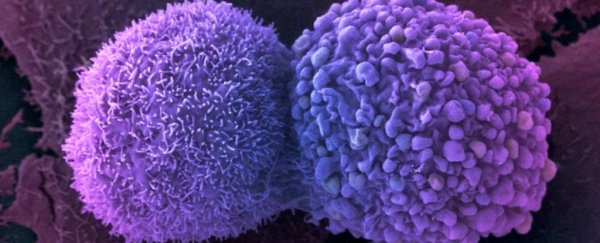CRISPR-Cas9 is the gene editing tool that promised to change the world.
In the short time since its discovery, it has snipped HIV out of human immune cells, sparked a biomedical race between the US and China to work toward bioengineered humans, and now scientists have used CRISPR-Cas9 to slow the spread of cancer.
Every living cell goes through a reproduction cycle, known as the 'cell cycle' – a sequence of events that result in cell growth and division.
When this cycle gets out of hand, it becomes a serious and life-threatening problem. Once a cell becomes cancerous it will divide without stopping and quickly invade surrounding the tissue.
And trying to stop cancer is no easy feat. Scientists have used a range of approaches to try to stop it from forming and spreading.
A previous study has turned the body's own immune system against cancer cells, and another team of researchers has created an artificial organ that can pump out cancer-fighting T-cells.
We've even worked out a way to cause particularly aggressive forms of cancer to self-destruct.
In the latest study, scientists from the University of Rochester have interrupted the cell cycle by targeting a protein responsible for preparing the cell for division, called Tudor-SN.
Tudor-SN influences the cell cycle by controlling microRNA, which are the molecules that fine tune the expression of thousands of genes.
"We know that Tudor-SN is more abundant in cancer cells than healthy cells, and our study suggests that targeting this protein could inhibit fast-growing cancer cells," says lead researcher, Reyad A. Elbarbary.
When Tudor-SN was removed from human cells, using CRISPR-Cas9, the level of microRNAs increases.
With more microRNAs in the mix, it slows down the genes that encourage cell growth. With these genes hindered, the cell transitions slowly to the cell division phase of the cell cycle.
The researchers used this approach to slow the growth of kidney and cervical cancer cells.
"Because cancer cells have a faulty cell cycle, pursuing factors involved in the cell cycle is a promising avenue for cancer treatment," said Lynne E. Maquat, senior researcher on the paper.
The next step for the research is to work out how Tudor-SN functions in combination with other molecules and proteins. That way, scientists may be able to identify the most appropriate drugs to target it.
While the researchers admit that they have a long way to go before we see this technology being used in humans, any new approach that could provide a cure to the millions of people living with cancer is always welcome.
The findings have been reported in Science.
